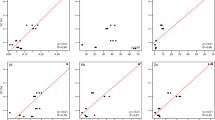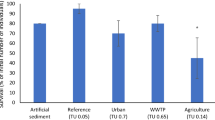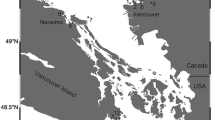Abstract
An integrated approach for ecological and ecotoxicological sediment assessments along the freshwater saltwater interface (FSI) and estuarine areas in general was developed, through the adaptation of recently proposed methods for the midge larvaChironomus riparius (an in situ assay based on post-exposure feeding for sediment toxicity assessments in freshwater systems) and the development of new techniques for the polychaeteHediste (Nereis) diversicolor (an in situ post-exposure feeding assay). Based on the previously proposed methods, improvements were made to the feeding quantification ofC. riparius fourth instar larvae. A method to quantify the post-exposure feeding ofH. diversicolor was developed and optimized under laboratory conditions using newly hatchedArtemia franciscana nauplii as a food source. Assay chambers and procedures fromC. riparius assays were easily adapted forH. diversicolor in situ exposures. Sediment assays using this integrated approach were successfully performed at an uncontaminated river-estuarine system. They consisted of a 48-h exposure followed by a 1-h post-exposure feeding for chironomids and a 2-h post-exposure feeding for polychaetes. Good recovery rates were obtained after the 48-h field exposure. Fluctuations in various physicochemical variables at the FSI, due to the tidal regime, did not significantly influenceC. riparius larval post-exposure feeding rates, suggesting that uncontaminated freshwater sites located upstream of FSI areas can be used as reference sites forC. riparius in situ evaluations in estuaries. Adapted assay chambers and procedures were suitable forH. diversicolor in situ exposures.
Similar content being viewed by others
Literature Cited
American Public Health Association. 1995. Standard Methods for the Examination of Water and Wastewater, 19th edition. American Water Works Association, Water Environmental Federation, and American Public Health Association, Washington, D.C.
American Society for Testing and Materials. 2002. Standard guide for conducting acute toxicity tests on test materials with fishes, macroinvertebrates, and amphibians, Designation E 729–96.In ASTM Annual Book of Standards, Volume 11.05 American Society for Testing and Materials, Philadelphia Pennsylvania.
Berner, E. K. andR. A. Berner. 1996. Global Environment: Water, Air and Geochemical Cycles. Prentice Hall, Upper Saddle River, New Jersey.
Bervoets, L., R. Blust, andR. Verheyen. 1996. Uptake of zinc by the midge larvaeChironomus riparius at different salinities: Role of speciation, acclimation, and calcium.Environmental Toxicology and Chemistry 15:1423–1428.
Brent, R. N. andE. E. Herricks. 1998. Post-exposure effects of brief cadmium, zinc, and phenol exposures on freshwater organisms.Environmental Toxicology and chemistry 17:2091–2099.
Buchanan, J. B. andJ. M. Kain. 1971. Measurement of the physical and chemical environment, p. 30–58.In N. A. Holme and A. D. McIntyre (eds.), Methods for the Study of Marine Benthos. Blackwell Scientific Publications, Oxford, U.K.
Castro, B. B., L. Guilhermino, andR. Ribeiro. 2003. In situ chambers and procedures for assessment of sediment toxicity withChironomus riparius.Environmental Pollution 123:325–335.
Chapman, P. M. andF. Wang. 2001. Assessing sediment contamination in estuaries.Environmental Toxicology and Chemistry 20: 3–22.
Chappie, D. J. andG. A. Burton, Jr. 2000. Applications of aquatic and sediment toxicity testing in situ.Soil Sediment Contamination 9:219–245.
Costa, M. J., F. Catarino, andA. Bettencourt. 2001. The role of salt marshes in the Mira estuary (Portugal).Wetland Ecological Management 9:121–134.
Crane, M., M. Higman, T. Olsen, P. Simpson, A. Callaghan, T. Fisher, andR. Rheir. 2000. An in situ system for exposing aquatic invertebrates to contaminated sediments.Environmental Toxicology and Chemistry 19:2715–2719.
Díez, G., M. Soto, L. Cantón, M. C. Vaquero, andI. Marigómez. 2000.Hediste (Nereis) diversicolor as bioindicator of metal and organic chemical bioavailability: A field study.Ecotoxicology and Environmental Restoration 3:7–15.
Guillard, R. R. L. 1983. Culture of phytoplankton for feeding marine invertebrates, p. 108–132.In J. Berg, Jr. (ed.), Culture of Marine Invertebrates. Hutchinson-Ross, Stroudsberg, Pennsylvania.
Hickman, Jr.C. P., L. S. Roberts, andA. Larson. 1997. Integrated Principles of Zoology. Brown Publishers, Dubuque, Iowa.
Leppänen, M. T., J. P. Postma, D. Groenendijk, J. V. K., Kukkonen, andM. C. Buckert-de Jong. 1998. Feeding activity of midge larvae (Chironomus riparius Meigen) in metal-polluted river sediments.Ecotoxicology and Environmental Safety 41:251–257.
Maltby, L., S. A. Clayton, R. M. Wood, andN. McLoughlin. 2002. Evaluation of theGamarus pulex in situ feeding assay as a biomonitor of water quality: Robustness, responsiveness, and relevance.Environmental Toxicology and Chemistry 21:361–368.
Maltby, L., T. J. Kedwards, V. E. Forbes, K. Grasman, J. E. Kammenga, W. R. Munns, Jr.,A. H. Ringwood, J. S. Weis, andS. N. Wood. 2001. Linking individual-level responses and population-level consequences, p. 27–82.In D. J. Baird and G. A. Burton, Jr. (eds.), Ecological Variability: Separating Natural from Anthropogenic Causes of Ecosystem Impairment. Society of Environmental Toxicology and Chemistry Press, Pensacola, Florida.
McWilliam, R. A. andD. J. Baird. 2002a. Application of postexposure feeding depression bioassays withDaphnia magna for assessment of toxic effluents in rivers.Environmental Toxicology and Chemistry 21:1462–1468.
McWilliam, R. A. andD. J. Bird. 2002b. Post-exposure feeding depression: A new toxicity endpoint for use in laboratory studies withDaphnia magna.Environmental Toxicology and Chemistry 21:1198–1205.
Moreira dos Santos, M., I. Moreno-Garido, F. Gonçalves, A. M. V. M. Soares, andR. Ribeiro. 2002. An in situ bioassay for estuarine environments using the microalgaPhaeodactylum tricornutum.Environmental Toxicology and Chemistry 21:567–574.
Pereira, A. M. M., A. M. V. M. Soares, F. Gonçalves, andR. Ribeiro. 1999. Test chambers and test procedures for in situ toxicity testing with zooplankton.Environmental Toxicology and Chemistry 18:1956–1964.
Péry, A. R. R., R. Mons, P. Flammarion, L. Lagadic, andJ. Garric. 2002. A modeling approach to link food availability, growth, emergence, and reproduction for the midgeChironomus riparius.Environmental Toxicology and Chemistry 21:2507–2513.
Ristola, T., J. Pellinen, M. Ruokolainen, A. Kostamo, andJ. V. K. Kukkonen. 1999. Effect of sediment type, feeding level, and larvae density on growth and development of a midge (Chironomus riparius).Environmental Toxicology and Chemistry 18:756–764.
Soares, S., I. Cativa, M. Moreira-Santos, A. M. V. M. Soares, and R. Ribeiro. A cost-effective sublethal in situ sediment assay withChironomus riparius based on post-exposure feedingArchives of Environmental Contamination and Toxicology (In press).
Zar, J. H. 1996. Biostatistical Analysis, 3rd edition. Prentice Hall, Upper Saddle River, New Jersey.
Author information
Authors and Affiliations
Corresponding author
Rights and permissions
About this article
Cite this article
Soares, S., Moreira, S., Andrade, S. et al. Freshwater-saltwater interface and estuarine sediment in situ assays based on post-exposure feeding of chironomids and polychaetes. Estuaries 28, 314–319 (2005). https://doi.org/10.1007/BF02732864
Received:
Accepted:
Issue Date:
DOI: https://doi.org/10.1007/BF02732864




